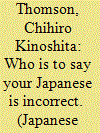| Srl | Item |
| 1 |
ID:
084529


|
|
|
|
|
| Publication |
2008.
|
| Summary/Abstract |
The paper visits some thoughts of educationists in the past to consider a sustainable future for Australian Japanese language education at the coal face of high attrition and scarcity of funds. Drawing upon the concept of 'andragogy' and a sociocultural approach to learning, the paper proposes that we should shed metaphorical walls outside of and in the classrooms in order to open access to more diverse resources and encourage more intense engagement by the learners in the classroom learning community. The new learning environment is termed 'a classroom without walls'.
|
|
|
|
|
|
|
|
|
|
|
|
|
|
|
|
| 2 |
ID:
117500


|
|
|
|
|
| Publication |
2012.
|
| Summary/Abstract |
What keeps learners of Japanese going in formal study? In Australia, few continue to an advanced level of the language, despite large numbers of learners. This study found that compared to discontinuers, continuers showed much higher levels of motivation and integrative orientation, and their attitudes towards learning were much more positive. They showed greater autonomous learning, and engaged in more self-initiated activities outside the classroom. In interviews, advanced learners explained the paths that enabled them to continue, yet indicated that university policies affect continuation through timetable and study program restrictions. The predominant reason to continue was the hope to travel to Japan, but an interest in Japanese culture and in Japanese popular culture (J-pop) products (e.g., anime, manga) also was prominent. The enjoyment of J-pop was implicated at least partially in both retention and attrition in Japanese. It provides the motivation to learn Japanese, and in a cyclical fashion, the learning of Japanese itself is consumed so as to further consume J-pop. It may also be the case that once appetites for language consumption are satisfied, some learners could abandon formal study of Japanese at a relatively early stage.
|
|
|
|
|
|
|
|
|
|
|
|
|
|
|
|
| 3 |
ID:
100298


|
|
|
|
|
| Publication |
2010.
|
| Summary/Abstract |
This paper discusses the Japanese language used by JSL learners in Japan, while examining JSL classrooms as public space. It draws upon JSL literature, Japanese textbooks and their discourses to find the kinds of Japanese that are taught and used in JSL classrooms and how they are presented and consumed, and it observes how diversity in learners' language is dealt with inside and outside of JSL classrooms in Japan, keeping in view the danger of 'colonisation' of classrooms. It will then study new developments where JSL speakers are participating in development of their own 'third space', which values hybridity more than diversity, and in turn the continuous re-construction of the public space.
|
|
|
|
|
|
|
|
|
|
|
|
|
|
|
|